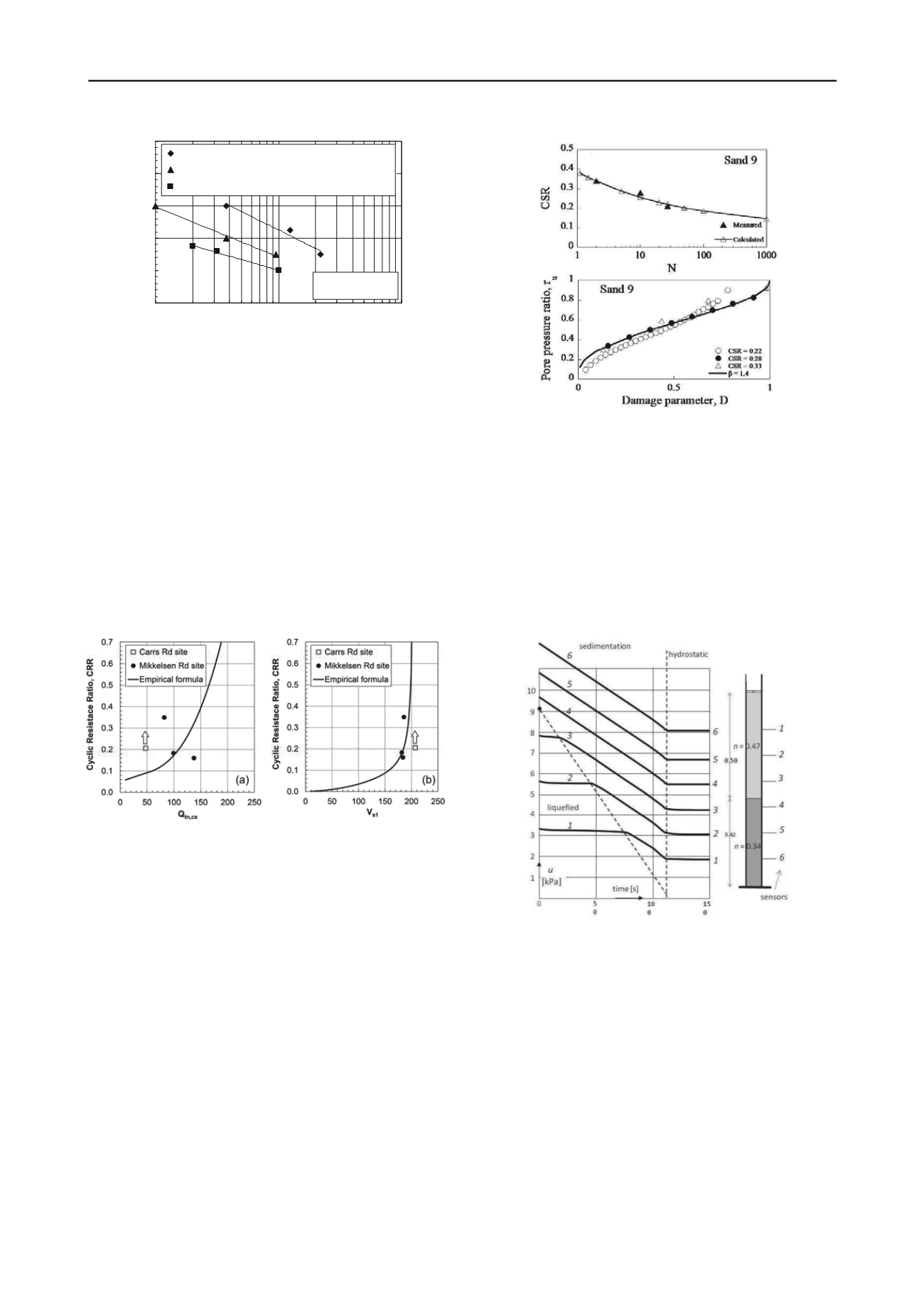
1402
Proceedings of the 18
th
International Conference on Soil Mechanics and Geotechnical Engineering, Paris 2013
0.0
0.1
0.2
0.3
0.4
0.5
1
100
Number of Cycles to reach ru = 1.0
Cyclic Stress Ratio, CSR
10000
No rth Co as t Ca lc a re o us S and
S ilic e o us S and ( A ) ( Hus s e in , 200 8 )
S ilic e o us S and ( B ) ( Ev ans & Zho u , 1995 )
σc ' = 100 kP a
Dr = 40 %
`
Figure 10. Liquefaction susceptibility of calcareous and siliceous sands
(
Elmamlouk et al.
).
Another study on peculiar soils is presented by
Orense &
Pender
(New Zealand) on ‘Liquefaction characteristics of
crushable pumice sand’ which, like other volcanic soils, is
poorly investigated in literature. Undrained CTX tests were
performed on reconstituted specimens of uniform sand and
undisturbed frozen samples of well-graded sandy silt. The
effects of D
r
and
c
on the liquefaction resistance were not as
significant compared to that of hard-grained sands. Empirical
liquefaction procedures derived for hard-grained soils were
assessed by comparing the CRR (this time evaluated as CSR
corresponding to 15 cycles) from the CTX tests on undisturbed
specimens with those from cone penetration (CPT) and seismic
dilatometer (sDMT) tests at the sampling sites. Due to particle
breakage, the penetration-based methods did not agree well with
the laboratory values, while that based on shear wave velocity
(Andrus & Stokoe, 2000) showed better correlation (Fig. 11).
Figure 11. Comparison between CRR from CTX and those from CPT
(a) and V
S
(b) empirical methods (
Orense & Pender
).
Åhnberg et al.
(Sweden) report a comprehensive study on
’Degradation of clay due to cyclic loadings and deformations’
including CTX tests on many soft clays with variable frequency,
highlighting that the cyclic overstrength was proportional to the
logarithm of strain rate. They also mention that the cyclic
resistance in terms of cyclic/static strength ratio increased with
decreasing sensitivity and increasing organic content, although
more specific correlations are not explicitly reported.
3.4
Analytical and physical modelling
Park & Ahn
(South Korea) propose an interesting ‘Accumulated
stress based model for prediction of residual pore pressure’. The
model uses a damage parameter, function of the cyclic stress
ratio and of the length of the shear stress path, to transform the
pore pressure model by Seed et al. (1975), which is instead
based on the equivalent number of cycles. The formulation can
be therefore incorporated in coupled effective stress analyses of
dynamic transient motions in the time domain. The calibration
procedure of the parameters, based on the cyclic resistance
curves measured in stress-controlled cyclic tests, was
successfully validated through comparisons with published and
original laboratory test data on clean and silty sands (Fig. 12).
Figure 12. Comparison of measured and predicted cyclic resistance and
pore pressures (
Park & Ahn
).
The paper ‘Liquefaction impact revisited’ by
Barends et al.
(Holland) reports laboratory tests on the variation of partial
liquefaction with space and time. 1D (soil column) and 3D
(cylindrical tub) models were filled with loose sand,
respectively overlying and surrounded by a denser one, and
instrumented to measure pore pressures and displacements
under impact loads. When even partial liquefaction occurred,
significant pore pressures arose also in the non-liquefied
surroundings and slowly dissipated during the sedimentation of
the liquefied mass (Fig. 13). The related porosity decrease was
however small enough that the sand remained loose, and re-
liquefaction was likely to occur due to subsequent new shaking.
Figure 13. Typical pore pressure records after a full liquefying impact
load (
Barends et al.
).
4 LIQUEFACTION: EMPIRICAL METHODS, FIELD
OBSERVATIONS AND COUNTERMEASURES
4.1
Empirical methods
Katzenbach et al.
(Germany) critically review the ‘Recent
developments in procedures for estimation of liquefaction
potential of soils’ in relation with Eurocode 8 (2010) as well as
the methods described in the NCEER workshops (Youd et al.
2001). They discuss the main factors influencing the evaluation
of CSR and CRR, claiming for more refinements and univocal
approaches in terms of definition of screening criteria, stress
reduction factor r
d
, effects of fines content, magnitude scaling
factor. They also suggest to introduce more details in EC8 about
the use of penetration resistance and of V
S
.
Wang et al.
(China) discuss the ‘Performance-based
evaluation of saturated loess ground liquefaction’ which
supports recent updating of the seismic guidelines of Gansu


